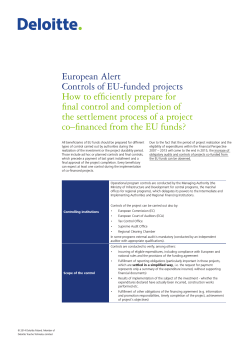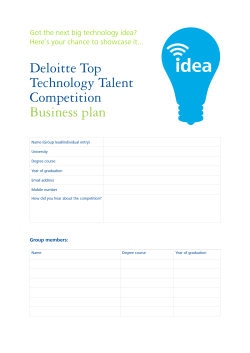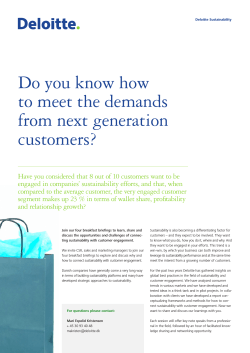
. Think ahead Business planning for the P&C industry
22943 jc Business planning:22943 jc Business planning 1/2/08 11:42 Page 3 Think ahead. Business planning for the P&C industry . . . . Audit Tax Consulting Corporate Finance 22943 jc Business planning:22943 jc Business planning 1/2/08 11:42 Page 4 Think ahead Business planning for the P&C industry The challenges ahead The potential for effective Business Planning is often under-recognised ‘Business Planning’ covers a wide variety of inter-related but separate activities, all culminating in a business plan. The business plan sets out the company’s internal and external strategic objectives and how the company intends to achieve those objectives. This plan gets driven down through the company by the budgeting process. The need for more robust and strategic planning by senior management is increasingly important for insurance and reinsurance companies due to a number of factors, including: • the softening market; • inflow of new capital; The inter-relationship of activities within Business Planning creates particular challenges From our experience there are a number of key challenges that need to be addressed in order to obtain the maximum benefit from the planning process: • Generic planning tools struggle to handle the additional complexities of the insurance industry. • Key resources spend considerable additional effort working around the limitations of the chosen tools, rather than focusing on business issues. • The ability to quickly understand the impact of certain scenarios on the financial forecasts i.e. sophisticated ‘what-if’ analysis. • increased shareholder expectation; • The significant amount of configuration required may lead to difficulty in supporting such a solution internally, especially over the longer term. • globalisation of the insurance industry; and • a changing global regulatory environment. Revenue planning is a key component of Business Planning Revenue is the lifeblood of any business. Knowing the timing and source of revenue streams is therefore key to being able to optimise its use. Figure 1 illustrates the central role of revenue planning within the planning function. The majority of insurance and reinsurance companies recognise this. Although revenue planning often sits at the heart of sophisticated enterprise systems, the demands for flexibility and speed lead to many companies relying on unstructured systems, particularly spreadsheets. These tend to be developed on an ad-hoc basis over a number of years and require the dedicated expertise of key individuals for their continued usefulness. This results in risks around flexibility, scalability, auditability, key-man risk and operational effectiveness. • Projects need a number of extended iterations before a workable solution is created. This leads to increased cost and implementation delay. • The challenges presented above significantly increase the risk of non-delivery. • There is a high likelihood of reduction in planned scope to safeguard the delivery of key aspects of revenue planning within acceptable timescales and budgets. Therefore, the full value is often never realised resulting in a less effective and less efficient planning capability. • The configuration environment, language and semantics constrain planning activities. Insurance companies face additional complications within the revenue planning process, including: Figure 1: Functional position of revenue planning • taking account of claims forecasts split between claim types; Finance department • external reinsurance arrangements and different types of reinsurances; and Planning HR General Revenue Planning Planning (RPE) Reference Expense Underwriting • intra-group reinsurance arrangements. Business planning requires a model capable of handling all the above complexities. This is of paramount importance as claims are an insurance company’s biggest expense and are also inextricably linked to revenue. Reporting, particularly from Excel based models, can also be inflexible and uninformative. Adjusting models and their outputs to take account of new legislation or regulatory requirements is a time consuming, error-prone and expensive process. The Revenue Planning Engine has been developed as a direct response to the need to reduce the risks and improve the effectiveness of business planning for general insurers. 22943 jc Business planning:22943 jc Business planning 1/2/08 11:42 Page 5 Think ahead Business planning for the P&C industry Deloitte Revenue Planning Engine • multiple reinsurance contracts, including intra-group reinsurance; An innovative solution to a complex business requirement Deloitte’s Revenue Planning Engine (RPE) is a unique, market-leading product that specifically deals with the complexities of the insurance and reinsurance industry. It has been designed by insurance professionals specifically for use by insurance companies. The RPE consists of a .NET engine that can easily be integrated and configured with other systems and a custom-built user interface. The secure and controlled environment of the RPE enables the user to quickly adjust the underlying assumptions and separately save the resulting revenue projections. This is combined with the ability to plan and report at different levels of detail and allows the user to carry out stress and scenario testing on the key drivers of the business – e.g. premium rate movements, retention rates, loss experience and investment experience. The insurance specific nature of the RPE enables it to deal with the complexity of planning within the insurance and reinsurance market including: • flexible reporting functions; • implementation of varying and complex group structures; • monthly, quarterly, half-yearly or annual projections; • multiple asset classes; • non-standard earnings for both premiums and claims (e.g. multiyear policies); • multiple types of expenses and commissions; • premium and claims inflation; and • international tax issues. The highly flexible reporting capability of the RPE is illustrated in figures 2. This allows the user to quickly compile standard regulatory reports, or design a report tailored to their own needs, whilst integrating with audit trail and version control requirements. For example, this allows Lloyd’s syndicates to generate reports in the format of a Syndicate Business Forecast, which can be submitted directly to the Lloyd’s of London website. The RPE is evolving to include new functionality and to incorporate the implications of future legislation. This currently includes upcoming changes to IFRS and the Solvency II requirements for European insurers. We provide the very highest level of service, with upgrades and installations supported by insurance and technology professionals and insurance specific documentation. • earning/underwriting year basis – enabling forecasts based on different accounting bases; • multiple currencies; Figure 2: Structure of the Revenue Planning Engine in an enterprise environment Expense planning Capital planning HR planning Enterprise Systems e.g. Financial Actuals Reserving Web Services/COM Interface Enterprise reporting Revenue Planning Engine Planning model Data Enterprise Database Calcs Interface Profit & Loss account Balance sheet Lines of business LoBs Entities Cash flow statements Assets RI Contracts Regulatory reports Finance Underwriting inputs Ad hoc reports Macro assumptions Portal & Workflow Technology Finance Acturial Operations 22943 jc Business planning:22943 jc Business planning 1/2/08 11:42 Page 6 Think ahead Business planning for the P&C industry Our strong relationships with marking leading planning tool providers, including Hyperion, Cognos, Business Objects and SAP, enhance our ability to ensure that our clients’ planning processes deliver full value for money. Our technology integration team are available to assist with the deployment of best practices using generic planning tools. The performance management process includes planning, budgeting and forecasting. Our view is that these should be fully integrated as a continuous cycle of activities. An Integrated Performance Management process ensures that every step of the process is fully informed. Changes made in one area of the process filter efficiently through the whole performance management system. Having an Integrated Performance Management (IPM) process is therefore crucial for deriving the maximum benefit from your performance management structure. techno logy archit ect ure Forecasting Strategy Intervention p le eo Analysis and organisa tio n Planning Value creation ev el o D The integration process Deloitte has extensive experience in all areas of Business Planning discussed in this document. ated e gr Int External reporting ew pment and re n Management reporting Co al 1. An integrated solution Revenue planning is only part of the planning process. The Deloitte RPE can be fully integrated with existing planning applications of your organisation. Figure 2 (below left) illustrates how the RPE is able to take the results of more generic expense and HR planning processes and incorporate these, along with assumptions regarding underwriting and finance, directly in future financial forecasts. In addition, it is able to allocate macro-level expenses to more microlevel activities. By integrating the Deloitte RPE with existing expense and HR planning systems, the result is an internally consistent, integrated business planning platform. Figure 3: Illustration of the cyclical relationship of the elements of the performance management process P Deloitte RPE is tailored to fit within your organisation The Deloitte RPEis available for use in 2 formats: Budgeting Operational reporting m mm tfor on info rm ation pla 2. Desktop application The standalone RPE product enables smaller and medium sized companies to quickly improve their business plans and advance their forecasting process. The facility to ‘Check In’ and ‘Check Out’ assumptions results in an easy to follow audit trail, allowing users to see the impact on their business of specific assumptions. The design of assumption and reporting templates can also easily be tailored to the individual company’s requirements, including generating Lloyd’s SBFs. 22943 jc Business planning:22943 jc Business planning 1/2/08 11:42 Page 1 Think ahead Business planning for the P&C industry Gurpreet Johal Partner Actuarial & Insurance Solutions Tel: +44 (0) 20 7303 3046 Mob: +44 (0) 7879 812 503 gjohal@deloitte.co.uk Stephen Ross Partner Corporate Finance – Insurance Tel: +44 (0) 20 7303 2185 Tel: +44 (0) 7810 655 898 steross@deloitte.co.uk Keith Taylor Senior Manager Actuarial & Insurance Solutions Tel: +44 (0) 20 7007 8284 Mob: +44 (0) 7771 826 248 keittaylor@deloitte.co.uk David Clissitt Partner Tax – Insurance Tel: +44 (0) 20 7303 2509 Mob: +44 (0) 7814 309 876 dclissitt@deloitte.co.uk Andrew Downes Partner Audit – Insurance Tel: +44 (0) 20 7303 5332 Mob: +44 (0) 7920 507 366 adownes@deloitte.co.uk Roy O’Neil Partner Consulting – Enterprise Applications Tel: +44 (0) 20 7303 0984 Mob: +44 (0) 7814 309 958 royoneil@deloitte.co.uk Richard Hurley Partner Consulting – Technology Integration Tel: +44 (0) 20 7303 8912 Mob: +44 (0) 7867 758 366 rhurley@deloitte.co.uk Deloitte & Touche LLP Hill House 1 Little New Street London EC4A 3TR Tel: +44 (0) 20 7936 3000 Fax: +44 (0) 20 7583 1198 www.deloitte.co.uk 22943 jc Business planning:22943 jc Business planning 1/2/08 11:42 Page 2 In this publication, Deloitte refers to one or more of Deloitte Touche Tohmatsu (‘DTT’), a Swiss Verein, its member firms, and their respective subsidiaries and affiliates. As a Swiss Verein (association), neither DTT nor any of its member firms has any liability for each other’s acts or omissions. Each of the member firms is a separate and independent legal entity operating under the names “Deloitte”, “Deloitte & Touche”, “Deloitte Touche Tohmatsu”, or other related names. Services are provided by the member firms or their subsidiaries or affiliates and not by the DTT Verein. In the UK, Deloitte & Touche LLP is the member firm of DTT, and services are provided by Deloitte & Touche LLP and its subsidiaries. For more information, please visit the firm’s website at www.deloitte.co.uk Deloitte & Touche LLP is authorised and regulated by the Financial Services Authority. This publication has been written in general terms and therefore cannot be relied on to cover specific situations; application of the principles set out will depend upon the particular circumstances involved and we recommend that you obtain professional advice before acting or refraining from acting on any of the contents of this publication. Deloitte & Touche LLP would be pleased to advise readers on how to apply the principles set out in this publication to their specific circumstances. Deloitte & Touche LLP accepts no duty of care or liability for any loss occasioned to any person acting or refraining from action as a result of any material in this publication. © Deloitte & Touche LLP 2008. All rights reserved. Deloitte & Touche LLP is a limited liability partnership registered in England and Wales with registered number OC303675. A list of members’ names is available for inspection at Stonecutter Court, 1 Stonecutter Street, London EC4A 4TR, United Kingdom, the firm’s principal place of business and registered office. Tel: +44 (0) 20 7936 3000. Fax: +44 (0) 20 7583 1198. Designed and produced by The Creative Studio at Deloitte, London. Member of Deloitte Touche Tohmatsu
© Copyright 2025





















